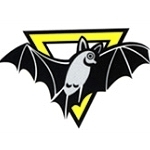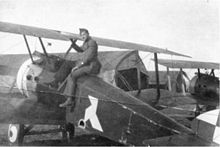
The French Air and Space Force (AAE) is the air and space force of the French Armed Forces. It was the first military aviation force in history, formed in 1909 as the Service Aéronautique, a service arm of the French Army; it became an independent military branch in 1934 as the French Air Force. On 10 September 2020, it assumed its current name, the French Air and Space Force, to reflect an "evolution of its mission" into the area of outer space.

The Polish Air Forces was the name of the Polish Air Forces formed in France and the United Kingdom during World War II. The core of the Polish air units fighting alongside the Allies were experienced veterans of the 1939 invasion of Poland. They contributed to the Allied victory in the Battle of Britain and Allied air operations during the war.

The Belgian Air Component is the air arm of the Belgian Armed Forces, and until January 2002 it was officially known as the Belgian Air Force. The Belgian military aviation was founded in 1909 and is one of the world's oldest air services.
The No. 341 Squadron also known in French as Groupe de Chasse n° 3/2 "Alsace", was a Free French squadron in the RAF during World War II.
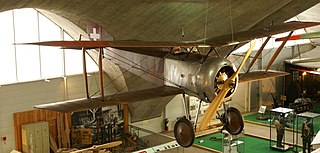
The Hanriot HD.1 was a French World War I single-seat fighter aircraft. Rejected for service with French squadrons in favour of the SPAD S.VII, the type was supplied to the Belgian Army′s Aviation Militaire Belge and the Corpo Aeronautico Militare of the Royal Italian Army, with both of which it proved highly successful. Of a total of about 1,200 examples built, 831 were produced by Italian companies under licence.

The 1st Wing is a wing in the Air Component of the Belgian Armed Forces, located at Beauvechain Air Base.

349th Squadron is a fighter squadron in the Air Component of the Belgian Armed Forces. The squadron traces its origins to No. 349 (Belgian) Squadron of the Royal Air Force, founded in 1942 as part of the Free Belgian forces during World War II. It was transferred to the re-established Belgian Air Force in 1946, together with 350th Squadron. Considered an "honorary" squadron, it retained its original name and numbering and has been flying under the Belgian flag ever since. Today it is part of the 10th Tactical Wing, operating the F-16 Fighting Falcon from Kleine Brogel airbase.

The 1st Squadron is a Recce squadron in the Air Component of the Belgian Armed Forces. Based at Florennes air base, it is part of the 2nd Tactical Wing and operates the General Dynamics F-16 Block 20 MLU Fighting Falcon.

The 350th Squadron is a fighter squadron in the Air Component of the Belgian Armed Forces. It was originally formed in 1941 as No. 350 (Belgian) Smaldeel of the Royal Air Force during World War II. The unit was transferred to the Belgian Air Force, together with 349th Squadron, in 1946. Based at Florennes air base, the unit is now part of the 2nd Tactical Wing and operates F-16 Fighting Falcons.
Beauvechain Air Base is a Belgian Air Component military airfield in Belgium, located 3 nautical miles south of Beauvechain in Wallonia ; 20 mi (32 km) east-southeast of Brussels.

Toul-Croix De Metz Airfield is a former military airfield which is located approximately one mile (1.6 km) northeast of Toul ; 160 miles (260 km) east of Paris.
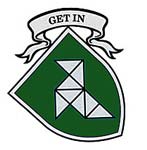
9 Squadron is a training squadron of the Belgian Air Component, constituting the Basic Flying Training School together with 5 Squadron.
The 5me Escadrille de Chasse was the second fighter squadron of the Belgian Air Component. The squadron was founded during World War I, reorganized into a dedicated fighter unit under its new designation of 10me Escadrille de Chasse in March 1918, and became part of a fighter wing before war's end.

The 11ème Escadrille de Chasse was the third and last fighter squadron of the Belgian Air Component during World War I. It was organized as a dedicated fighter unit in March 1918, to fill out a fighter wing that supported the Belgian Army's advance near war's end.
The Groupe de Chasse was Belgium's first dedicated fighter wing. It was created in March 1918 at Les Moëres aerodrome near Veurne. On request of King Albert I, Captain-commandant Fernand Jacquet was appointed Commanding Officer, and the Groupe de Chasse also became known as the Groupe Jaquet. It consisted of the 9ème Escadrille de Chasse, the 10ème Escadrille de Chasse and the 11ème Escadrille de Chasse.
Michel G. L. "Mike" Donnet, was a Belgian pilot who served in the Belgian Army and British Royal Air Force (RAF) during the Second World War. He shot down four enemy aircraft confirmed, and achieved the RAF rank of wing commander. After the war, he returned to the Belgian Air Force, and held several important commands before retiring in 1975.

Escadrille 103 of the French Air Force was an elite aviation unit on the Western Front during World War I. One of its many aces, René Fonck was the highest scoring Allied fighter-pilot.

Fighter Squadron 2/30 Normandie-Niemen is a French Air and Space Force fighter squadron which flies the Dassault Rafale C from BA 118 Mont-de-Marsan Air Base. During a dormant period in 2009, the squadron was equipped with Dassault Mirage F1CT fighters and stationed at the BA 132 Colmar-Meyenheim Air Base.

The Escadron de Chasse 2/4 Lafayette is a squadron of the French Air and Space Force. It is currently stationed at BA 113 Saint-Dizier – Robinson Air Base, and is equipped with the Dassault Rafale C. The squadron has a long history dating back to the First World War, and has seen service in the Second World War, the French Indochina War and Algeria. It is now a nuclear strike squadron.
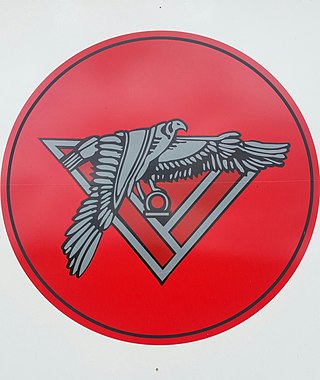
The 5th squadron is a training squadron which, together with the 9th squadron, forms the Basic Flying Training School of the Belgian Air Component.
